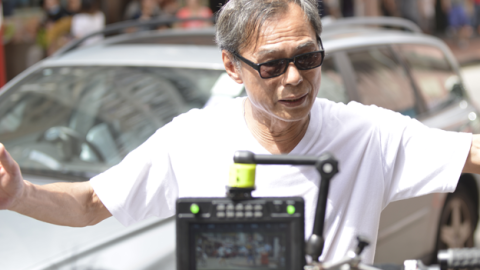Ringo Lam: Man on Fire
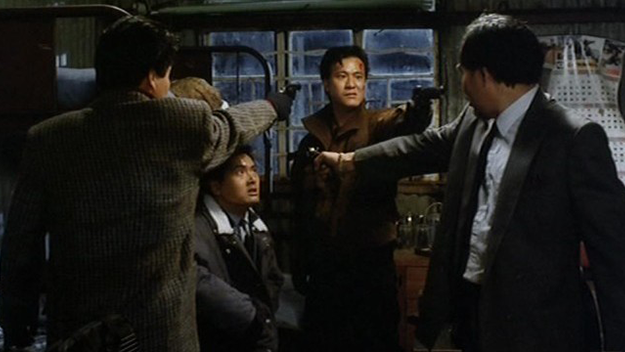
City on Fire
In August 1986, John Woo released A Better Tomorrow, his blockbuster crime movie that fused the heroic tropes of the wuxia genre to the gangster film, recasting triad criminals as martial-arts swordsmen. Street thugs were transformed into sworn brothers who lived by a chivalric code, with silk robes replaced by black trench coats and gleaming swords by twin Berettas. Seven months later, in February 1987, Ringo Lam released City on Fire, about an undercover cop who exploits this code of brotherhood to infiltrate a gang of trigger-happy strong-arm bandits. But the joke’s on him. He winds up being betrayed by his own brothers, the police, and left to bleed out on a pile of corpses, while the one man who still believes in brotherhood, the leader of the gang he just betrayed, is dragged away in chains.
The two movies ushered in a new era of Hong Kong action cinema and they have a lot in common. Both Woo and Lam were in career crisis, and these movies remade them. Woo was a washed-up comedy director who was hitting the bottle too hard. Lam had four romantic comedies under his belt, but a recent flop had put his career in jeopardy. Both movies starred Chow Yun-fat, a television star who hadn’t made his mark in movies yet, and both did well at the box office but Woo’s more overtly heroic film raked in a staggering $34 million, spawned a legion of imitators, and cast a shadow over Lam’s achievement. Then again, Lam’s achievement was the shadow to Woo’s brightly lit heroism.
Woo and Lam represent two schools of Hong Kong filmmaking. Woo comes from the long tradition of wuxia movies, going back to Chang Cheh’s One-Armed Swordsman (67), and even further to the martial arts novels of the 1920s. Lam comes from Hong Kong’s warts-and-all school of social realism. Directors like Alex Cheung (Man on the Brink, 81) and Kuei Chih-hung (The Criminals, 76) had popularized brutalist, streetwise movies, but this tradition extended all the way back to China’s first two feature films, Yan Ruisheng (21) and Woman Skeletons (21), both of them true crime stories shot on location.
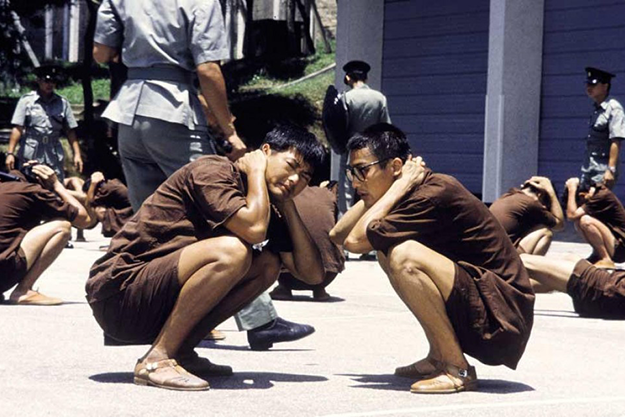
Prison on Fire
There’s more to Lam than his differences from Woo, but looking at how both directors treat their star, Chow Yun-fat, is revealing. He appeared in five movies for each man, and in Woo’s movies he dies often, going out like a hero, usually in slow motion, enduring bullet wounds with gritted teeth. Lam only kills Chow once, but he relishes mortifying his flesh. Chow is tortured gruesomely in City on Fire before he’s killed and dumped on the floor of a crummy warehouse like a sack of garbage. Lam’s prison film, Prison on Fire (87), was the blockbuster that made Lam a superstar director and in it Chow is beaten, stabbed, and broken until he loses his mind and gnaws off part of a guard’s face. No faces get bitten in the sequel, Prison on Fire II (91), but Chow gets beaten almost twice as much. In Full Contact (92), Chow plays a bouncer betrayed by a gang of cartoonish crooks, and here he’s stabbed, shot, beaten, has two fingers sliced off, and is left for dead, only to return from the grave in the second half of the picture, Pale Rider style, to exact revenge. Even a sweet film like Lam’s Wild Search (89) takes time out for Chow’s alcoholic cop to get jumped by thugs while on a date and beaten so badly he can no longer stand.
Woo is interested in the legendary, the heroic, the mythic. Lam is interested in the prosaic, the everyday, the real. Lam ruthlessly applies the reality principle not just to the torment of his star’s body, but to every aspect of his films. He attended the trial of the gang who robbed the Time Watch Company to get material for City on Fire (“I found out they didn’t dress well, and everybody looked like a loser,” he said in a 2014 interview with the Hong Kong Film Archive), he hired his older brother, Nam Yin, to write the script for Prison on Fire (“My brother’s a walking encyclopedia of the underworld . . . He racked up some 200 pages . . . It’s fantastic raw material”), and Wild Search largely takes place in one of the rural communities in Hong Kong’s New Territories, with the village traditions and its web of complex inter-relationships as carefully documented as in an anthropology thesis. In his masterpiece, the cop drama Full Alert (97), the process of opening a vault door becomes an excruciating exercise in absurdity as the cops pose, guns drawn, then stand down as the unlocking process drags on, then raise their guns, then lower them again, over and over until the tension fizzles from the scene and we’re left with grim slapstick.
Location work is essential to Lam’s aesthetic. Full Alert is a riff on Michael Mann’s Heat (95), as a group of cops, led by Officer Pao (Lau Ching-wan), stalks an architect (Francis Ng) and his Taiwanese gang, trying to determine the target of their next big heist. The movie staged a massive car chase on congested Hong Kong streets without location permits, racing past confused pedestrians, weaving their vehicles between moving trams. When Lam was refused access to the Jockey Club race track, he sent in a hidden camera crew to get B-roll. When they were thrown out, he sent them right back in again.
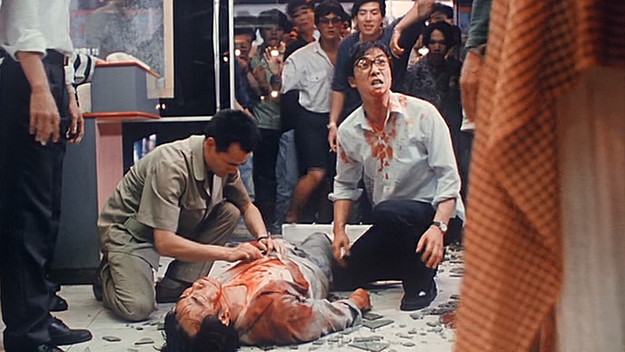
School on Fire
His commitment to realism sometimes blinds him to the realities of the market. Coming off the high of Prison on Fire’s box office success, Lam directed School on Fire (88), a savage indictment of the Hong Kong school system, portraying it as a forced march that batters students into submission, stuffing their skulls with useless facts, before spitting them out into a city where jobs are few and the future is bleak. In this grueling hell, schoolkids flock to the side of glamorous triads like the flashy Brother Smart (Roy Cheung), begging for his favor, peddling his pills, and taking the rap for his crimes. When nice girl Chu (Fennie Yuen) witnesses a triad beatdown and agrees to testify, Brother Smart’s wrath knows no bounds and he breaks her spirit until she’s a pill-popping hooker, turning tricks to repay a fabricated debt, while all the adults in her life—the local cop, her teachers, her ex-triad dad—stand helplessly on the sidelines.
Needless to say, the Hong Kong censor board wasn’t too happy and insisted on more than 30 cuts. Lam protested, but ultimately conceded and released his movie maimed and hobbled. It did decent business at the box office, but critics and politicians slammed it as socially irresponsible and Lam got a reputation for being “difficult.” What’s most notable about the movie today is not its street-level realism but the touches of feverish poetry that keep breaking through. When a fight in a teahouse shatters dozens of birdcages, Lam cuts to an exterior of shot of the building, leaving the sound of the brawl on the soundtrack as birds dart out its windows. When Sandy (Lee Lai-yui), Chu’s best friend, is pushed to the edge, she gulps pills, jumps on a motorcycle, and races through nighttime traffic, before muttering “I’ve had enough,” and steering right into the path of an oncoming truck. A scene later, Chu dry-swallows a handful of pills in sympathy and bagpipes wail on the soundtrack as she sets the school library on fire in slow motion howling: “I’ll never go to school again! I’ll never study again!” Melodramatic? Sure. Over the top? Of course. But in moments like this, Lam gives Hong Kong’s most marginalized citizens—students, prisoners, street criminals—moments of dramatic power and poetry usually reserved for its chivalrous heroes.
In interviews, Lam has stated that it’s the small moments that matter most to him in his movies—whether it’s the Chinese New Year celebration in Prison on Fire during which the convicts set aside their differences and dance together to Teresa Teng’s “The Moon Represents My Heart,” or the melancholy warbling of Forties songstress Bai Guang that plays over his one horror movie, Victim, or an escaped prisoner leaping off a cliff and into the pounding surf in Prison on Fire II. Lam views his characters as extensions of himself—restless and angry—and he views his movies as records of the time and place in which they were made. As he noted in a 1998 interview for the Hong Kong Film Festival, most of the locations in Full Alert are now gone, as is the Hong Kong that existed in 1997, crushed beneath the developer’s bulldozer. So, too, is the style of action filmmaking pioneered by Lam and Woo. At the end of Full Alert, as a storm boils on the horizon, the cop kills the crook, and order is restored, but everyone is too shaken to hide their murders behind a mask of heroism. Pao, the victorious cop, retreats to his patrol car and sits, sobbing, as the screen slowly fades to black. It’s an epitaph for a city that was once on fire and is now only ashes, a requiem for a style of action filmmaking that began in 1986 and ended here, where there are no more heroes, in 1997.
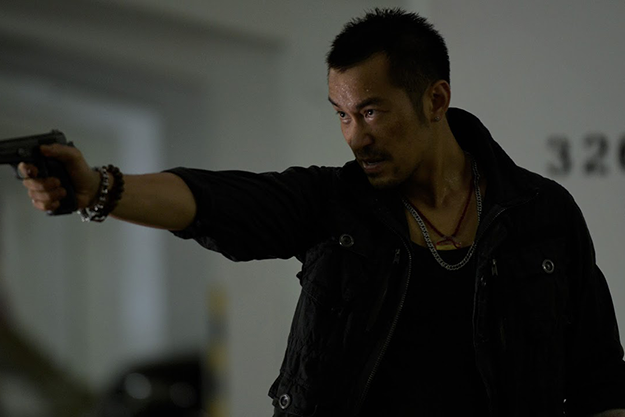
Wild City
Cut to 2015, and after a 12-year absence from feature films, Lam returns with Wild City, a movie he considers the third part of a loosely defined “City Trilogy” that includes City on Fire and Full Alert. Louis Koo plays T-Man, owner of a bar and a former cop who quit the force because he couldn’t bring himself to arrest his brother, Chung (Shawn Yue). When a Mainland sugar baby, Yan (Tong Liya), passes out in T-Man’s bar he gallantly sees her safely home, only to discover that her boyfriend is a triad lawyer who’s been looking for his lady because she stole a case of cash meant for greasing some palms to secure a casino license for one of his shady clients. The rest of the movie is a four-way chase between the lawyer and his triad client, some Taiwanese muscle they hire who quickly go rogue, the cops who suspect there’s more to this than meets the eye, and T-Man, Yan, and Chung. Cue heavy metal car chases, running fistfights in parking garages, and sedans smashing through double-decker buses.
In the old days, Lam’s crooks were motivated by gold, drugs, or guns, so it’s strange to see all this mayhem unleashed over a casino license, but as he ages, Lam has set aside worldly illusions. Gold, drugs, guns, casino licenses, they all boil down to the same thing: cold hard cash. Money is the dark matter of the Wild City universe, an invisible force that shapes absolutely everything. In the opening scene, Lam shoots the activity at T-Man’s bar less like a fun night out on the town, and more like a bunch of drones passing cash down an assembly line.
This being a Mainland Chinese co-production, Lam has to walk the same tightrope that Johnnie To did with his Drug War (12), portraying the police in a positive light, refusing to glorify criminality, making sure everyone gets their just desserts. Lam lacks To’s confidence, and he delivers a more restrained, less subtle picture than his past films. Like a pianist playing scales before tackling a concerto, Wild City feels like a warm-up, as Lam restages old scenes with slight twists—the race down Hong Kong streets is a version of the big car chase in Full Alert, and the countryside burial of a Taiwanese gangster is a restaging of the countryside burial of a Taiwanese gangster in Full Alert, right down to the participation of actor Jack Gao, this time playing the corpse. This aura of uncertainty feels odd coming from the normally self-assured Lam, but it raises the possibility that if this movie is just the warm-up, his next movie will be the main event. And Lam specializes in the knockout.



